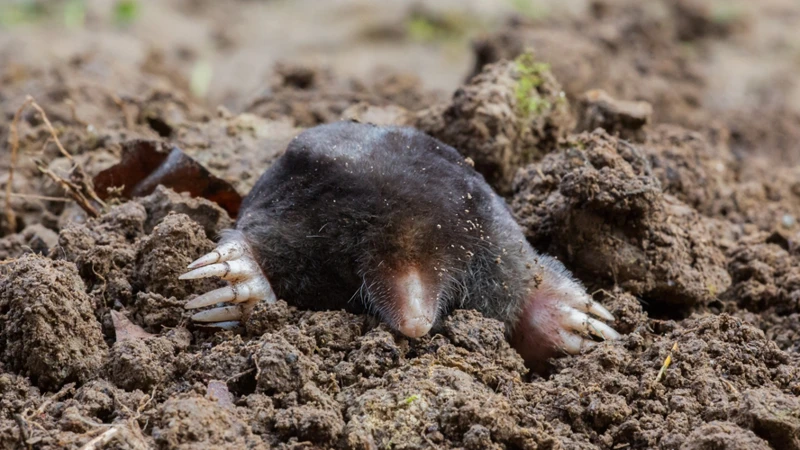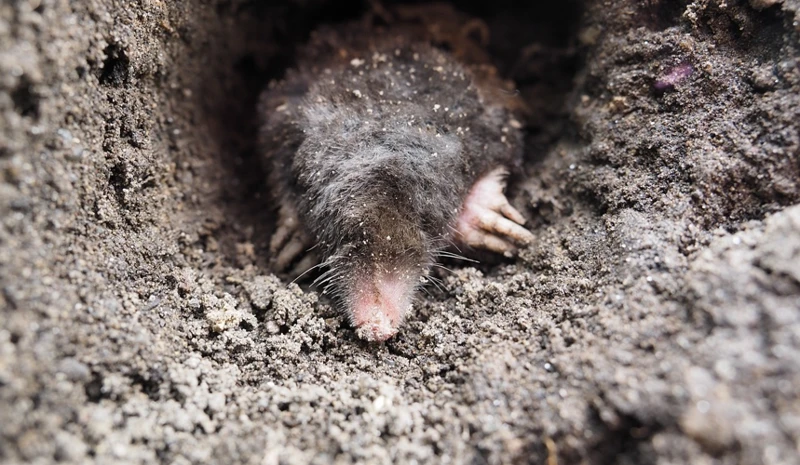Have you ever wondered how much sleep moles need? These tiny creatures seem to be always digging and creating tunnels at all hours of the day and night. Yet, like all living beings, they also need rest. In this article, we will explore the sleeping habits of moles and learn how much sleep they really need. But first, let’s take a closer look at these interesting creatures and their characteristics.
What Are Moles?

As we walk through our lawns or gardens, we might occasionally spot molehills and wonder about these mysterious creatures. Moles are small mammals that belong to the Talpidae family. They are known for their unique burrowing abilities and distinctive physical characteristics such as their pointed snouts and paddle-like feet. These animals are fascinating creatures who lead complex lives, from their foraging and hunting habits to their sleeping and mating routines. Let’s learn more about them and their daily activities. To understand moles better, we need to dive into their characteristics, daily routines, and unique habits, such as their hunting habits, eating habits, and mating habits.
Characteristics
Moles are small, burrowing mammals that are found in many parts of the world. Here are some of the key characteristics of moles:
| Characteristic | Description |
|---|---|
| Size | Moles are typically small, with most species only growing to around 4-6 inches in length. |
| Appearance | They have small eyes and ears, short fur that is usually dark brown or black in color, and a long, pointed snout that they use for burrowing. |
| Adaptations for burrowing | Moles have large, spade-like front paws that are adapted for digging and a cylindrical body shape that helps them move easily underground. |
| Diet | Moles are insectivores, primarily feeding on earthworms, grubs, and other small insects and invertebrates that they find underground. |
| Habitat | They are found in a variety of environments, including grasslands, forests, and even some urban areas. |
Understanding these characteristics is important when looking to prevent moles from damaging your lawn. Knowing their burrowing habits, daily routines, and social habits can help determine what the best solutions are for avoiding conflicts with these creatures. For more information on moles’ burrowing habits, daily routines, and social habits, refer to the related articles.
Do Moles Sleep?

As we observe various animals in the wild, it’s natural to wonder about their sleep patterns. Moles, in particular, have a unique lifestyle that makes us question how much rest they receive. With their subterranean homes and tireless digging, it may seem like they never take a break. However, research has shown that moles do indeed sleep, but their sleeping habits are vastly different from those of other animals. Let’s dig deeper and explore the world of moles and their sleep patterns.
Sleeping Habits
Moles are creatures that have a unique sleeping pattern. They are primarily nocturnal animals, which means they are active at night and sleep during the day. During the day, moles will burrow into the ground and create a network of tunnels and burrows. This is where they will rest and sleep when they are not actively pursuing food.
Moles have adapted to their underground lifestyle, and their sleeping habits reflect this. They are able to regulate their body temperature and conserve energy by sleeping in short bursts throughout the day. These short periods of sleep are usually around 4-6 hours long.
Despite their short periods of sleep during the day, moles are still able to get enough rest to stay healthy and active. Just like humans, they need rest to recharge their bodies and maintain their overall health. However, moles are able to sleep more efficiently than humans, sleeping for only short periods but still feeling refreshed.
It is interesting to note that moles are able to adapt their sleeping patterns based on their environmental factors. For example, during periods of food scarcity, moles may sleep more to conserve energy. Similarly, when the soil is too dry or too wet, moles may sleep more to avoid the harsh conditions above ground.
Moles sleep in short bursts throughout the day, which allows them to rest and maintain their energy levels. They are able to adapt their sleeping patterns based on their environment, ensuring that they remain healthy and active.
How Long Do They Sleep?
Moles are known to spend a majority of their time sleeping. It has been estimated that moles can sleep for up to 14 hours a day! That’s almost as much as a typical house cat. Moles have a high metabolism, which causes them to need more sleep in order to conserve energy.
Their sleeping patterns are also influenced by the weather and time of year. Moles tend to sleep more during the colder winter months and during periods of heavy rain or snow. In warmer months, they may be more active during the day and sleep less at night.
During their awake hours, moles are constantly active, tunneling and foraging for food. With all this activity, they need plenty of rest in order to recharge their batteries. So while it may seem like moles are always on the move, they actually spend a significant amount of time napping.
Moles’ Daily Activities

As mysterious and elusive creatures, moles have long captured our attention with their unique characteristics and habits. Beyond their sleeping patterns, the daily activities of moles offer a fascinating glimpse into their secretive lives. From foraging for food to mating and reproducing, moles are constantly hustling beneath the surface of our lawns and gardens. Let’s explore the daily rituals of these intriguing creatures, so we can better understand and appreciate their place in the ecosystem.
Foraging and Eating Habits
Moles are insectivores, meaning their primary diet consists of insects and other invertebrates. They are voracious eaters and can consume large quantities of food each day. Their foraging and eating habits are essential for their survival and reflect their unique adaptations to life underground.
Foraging Habits
Moles have specialized front paws that are designed for burrowing and hunting. They use their sense of smell and touch to locate prey, which they then capture with their sharp teeth. Moles are active foragers and can spend several hours each day searching for food. They hunt mainly at night or during the early morning when the soil is moist, making it easier for them to navigate and locate prey.
Eating Habits
Moles have a high metabolism and need to consume substantial amounts of food to maintain their energy levels. They consume mainly earthworms, grubs, and other insects, but they will also eat small rodents, reptiles, and birds if given the opportunity. Moles have large stomachs and can eat up to 80% of their body weight in a single day.
Below is an html table that summarizes moles’ foraging and eating habits:
| Foraging Habits | Eating Habits |
|---|---|
| Moles have specialized front paws for burrowing and hunting | They consume mainly insects, such as earthworms and grubs |
| They use their sense of smell and touch to locate prey | They will also eat small rodents, reptiles, and birds if given the opportunity |
| They are active foragers and hunt mainly at night or early morning | Moles have large stomachs and can eat up to 80% of their body weight in a single day |
Understanding moles’ foraging and eating habits can help you identify the signs of a mole infestation in your lawn or garden. If you notice tunnels or mounds of soil and disrupted vegetation, it could be a sign of a mole foraging for food.
Mating and Reproduction
Moles are solitary creatures and they only tolerate the company of other moles during breeding season. The breeding season for moles runs from February to May. During this time, males and females will come together for mating purposes.
Mating rituals:
– Moles have a unique courtship ritual where the male will push earth onto the female’s back and then proceed to mate with her.
– The courtship ritual can last for hours and the actual act of mating only lasts for a few seconds.
Gestation and birth:
– After mating, the female mole will have a gestation period of approximately 4-6 weeks.
– Moles give birth to litters of 2-5 young, known as pups, which are born blind and hairless.
– The young will spend the first few weeks of their lives in the safety of an underground burrow, where they are nursed by their mother.
Parental care:
– Moles are not known for their parental care, and the mother mole will typically abandon the young after they are weaned.
– The young will then have to fend for themselves and establish their own territories.
Moles may not be the most social of creatures, but they still manage to carry out successful mating and reproductive processes.
Preventing Moles from Disturbing Your Lawn
As much as we may appreciate moles for their unique and fascinating characteristics, they can also cause major frustration for homeowners when they make their way into our gardens and lawns. Not only do their tunneling activities create unsightly mounds and ridges that can make lawn maintenance difficult, but they can also disrupt the root systems of plants, creating further damage. So, what can we do to prevent moles from disturbing our lawns? Let’s explore some natural remedies and professional solutions that can help keep these subterranean mammals at bay.
Natural Remedies
One of the most effective ways to prevent moles from disturbing your lawn is through the use of natural remedies. These remedies are safe for both the environment and your family, and they help to keep moles at bay without the use of harmful chemicals. Some popular natural remedies for moles include:
| Castor Oil: | Castor oil works by coating the grubs and insects, which are the main source of food for moles, with an unpleasant taste. This causes moles to seek out other areas for food, effectively deterring them from your lawn. |
| Cayenne Pepper: | Cayenne pepper is a natural irritant that can be sprinkled on the soil’s surface to deter moles. The strong smell and taste of the pepper hinders the moles’ sense of smell, making it difficult for them to locate their food sources. |
| Coffee Grounds: | Used coffee grounds are a natural repellant for many pests, including moles. The coffee’s strong scent and bitter taste keeps moles away, while also enriching the soil with nitrogen, making it ideal for many plants. |
| Mothballs: | Mothballs are another effective natural remedy for deterring moles. The strong scent of the mothballs is very unpleasant to moles, and they will avoid areas where they detect this scent. |
While these natural remedies can be effective in deterring moles, remember that prevention is always better than cure. Regular lawn maintenance, such as mowing the lawn and removing any debris that might be attracting pests, can go a long way in preventing mole infestations in the first place.
Professional Solutions
If natural remedies fail to prevent moles from disturbing your lawn, you may need to consider professional solutions. These solutions can be more effective, but they also come with a higher cost.
Professional Solution | Description
— | —
Trapping | There are several types of traps that can be used to catch moles, including box traps and snap traps. Trapping can be effective, but it requires skill and patience.
Fumigation | Fumigation involves distributing a mole-repellent gas through the mole tunnels. This can be effective, but it also requires specialized equipment and training.
Mole-Repellent Sprays | There are many mole-repellent sprays available on the market. These sprays use chemicals or natural ingredients to discourage moles from tunneling in your lawn.
Sonic Repellents | Sonic repellents emit a sound or vibration that moles find irritating. These devices can be effective, but they must be placed strategically in the mole’s habitat.
Mole Bait | Mole bait is a poisonous substance that is placed in the mole’s tunnels. This is an effective way to kill moles, but it can also be hazardous to other animals and children.
When considering professional solutions, it’s important to do your research and choose a reputable company. Make sure the company has experience dealing with moles and can provide references. Also, be sure to read the fine print on any contracts or agreements to ensure that you understand the terms and costs involved.
Conclusion
After exploring the sleeping habits of moles, it is clear that these fascinating creatures do indeed sleep. Their sleeping habits may be different from those of humans and other animals, but they are equally important for their health and survival.
Despite their nocturnal and solitary nature, moles are an integral part of the natural ecosystem. They contribute to soil health by aerating and enriching the soil and controlling various pest populations. Therefore, it is essential to handle their presence in lawns and gardens with care.
There are some natural remedies and professional solutions available for preventing moles from disturbing your lawn, but it is important to consider the potential impact on the environment and other wildlife.
In conclusion, it is our responsibility to strike a balance between respecting the natural habits of moles while also mitigating any damage to our outdoor spaces. With careful consideration and informed decision-making, we can coexist peacefully and appreciate the unique characteristics and habits of these fascinating creatures.
Frequently Asked Questions
How do I know if I have moles in my lawn?
You may notice raised ridges and tunnels in your lawn, as well as small mounds of soil. Spongy patches of grass may also indicate the presence of moles.
Do moles only come out at night?
No, moles are active both during the day and at night.
Can moles damage my lawn?
While moles themselves won’t eat your plants, their tunnels can create air pockets and root damage, which can cause your grass to die or become discolored.
How can I prevent moles from digging in my lawn?
There are various natural remedies and professional solutions that can help deter moles from your lawn. These include planting deterrent plants and using mole-specific traps.
What do moles eat?
Moles primarily eat insects, earthworms, and other small invertebrates found in soil.
Do moles hibernate?
No, moles do not hibernate, but they may dig deeper tunnels in the winter to avoid colder temperatures.
Can moles transmit diseases to humans?
There is no evidence to suggest that moles can transmit diseases to humans.
How fast do moles dig?
On average, moles can dig about 1 foot per minute.
Do moles create living quarters underground?
Yes, moles create complex underground networks of tunnels and chambers that serve as their living quarters.
How long do moles live?
On average, moles live for about 2-3 years in the wild.







